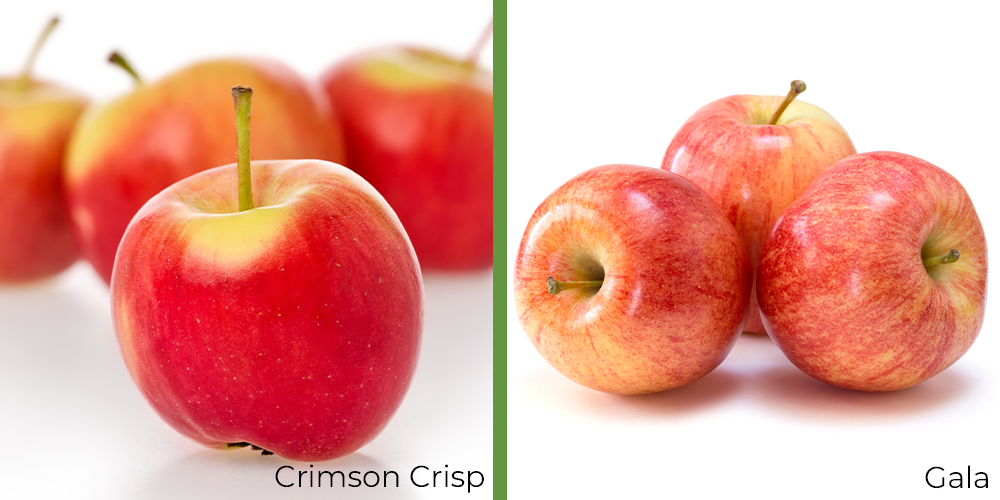Here are some bite-sized tips for growing your own apples!
As the star of countless songs and idioms, apples are right near the top of America’s favorite fruit. And you can grow them in your own yard! While it can take a couple of years for your trees to be productive, it’s well worth the wait—you’ll have plenty of apples to eat fresh, preserve, and add to recipes (like this Apple Clafoutis that we’ve been baking on repeat!).
Select an Apple Tree
Several types of apple trees can grow right here in Bettendorf—just be sure to check that the tag says it can grow in Zone 5. If you have a small space, consider planting a dwarf cultivar. Wallace’s recommends dwarf and semi-dwarf varieties for the home gardener. Most apple varieties aren’t self-pollinating, meaning you’ll need at least two different types of apples in your yard that flower at the same time. This will ensure bees and other insects pollinate the blossoms.
Flowering Crabapple trees can also be pollinators for apple trees. Depending on your space and when you want the fruit ready for harvest, you can choose from a number of options. Here are some of our favorites:
Crimson Crisp: Bright red and incredibly photogenic, this sweet-tasting apple has a delightful crisp. With trees growing up to 15 feet tall, Crimson Crisp apples will be ready to harvest in September.
 Gala: Ready for picking in September, Gala apples are crisp, medium-sized and semi-sweet. This is a common variety worldwide—you likely pass it every trip to the grocery store! Gala apple trees can grow to about 20 feet tall.
Gala: Ready for picking in September, Gala apples are crisp, medium-sized and semi-sweet. This is a common variety worldwide—you likely pass it every trip to the grocery store! Gala apple trees can grow to about 20 feet tall.
Honeycrisp: Another grocery store classic, Honeycrisp apples are juicy, extra-crisp, and sweet, making them a popular choice to grow for fruit fresh from the tree for eating. This tree grows up to 15 feet tall, and fruit will be ready in September.
 Jonagold: Derived from Jonathan and Golden Delicious cultivars, Jonagold apples are large, crispy, and yellow-green with pink. They’re tart like a Jonathan apple but sweet like a Golden Delicious, and the tree can grow up to 15 feet tall. A Jonagold apple tree doesn’t make the best pollinator partner to other apples, but it still requires at least another type of apple nearby so it can become pollinated itself. Consider growing Crimson Crisp, Honeycrisp, Gala, or Pristine to encourage pollination of Jonagold.
Jonagold: Derived from Jonathan and Golden Delicious cultivars, Jonagold apples are large, crispy, and yellow-green with pink. They’re tart like a Jonathan apple but sweet like a Golden Delicious, and the tree can grow up to 15 feet tall. A Jonagold apple tree doesn’t make the best pollinator partner to other apples, but it still requires at least another type of apple nearby so it can become pollinated itself. Consider growing Crimson Crisp, Honeycrisp, Gala, or Pristine to encourage pollination of Jonagold.
Pristine: Ready to be harvested in mid-July, Pristine apples are an excellent choice if you want fresh fruit earlier in the season. The apples are tart with yellow flesh. Pristine apple trees are resistant to many pests and diseases and grow up to about 15 feet tall.
Choose a Location
Find a spot in your yard with full sun (that is a place that gets at least six hours of direct sun during the summer days). If possible, opt for a spot on the north side of your house rather than the south. That way, you can avoid new growth being stimulated on warm days during the winter, which the frost would eventually kill. The soil should be well-draining with light to medium texture so that it still retains some water.
How to Plant an Apple Tree
Plant your tree in the springtime or early fall. Remove all the weeds within four feet of where your tree will go. If you’re planting more than one near each other, space them out by at least 15 feet. Dig a hole equally as deep and twice as wide as the rootball, then plant your tree. After spreading out the roots in the soil, making sure they aren’t too crowded, fill in the hole with soil, firming it down as you go.

Apple Tree Maintenance
Water regularly as the young tree establishes itself. For added support while the roots are still growing, it’s important to stake the young apple tree—or even throughout its entire life, for some dwarf varieties. You won’t need to fertilize until it has been established for a couple of years when the tree starts producing fruit. Apple trees are prone to pests and diseases.
While pesticides will do the trick, you can avoid using chemicals if you’re growing an organic garden by selecting a disease-resistant variety, or using anti-insect oils and natural predators, depending on the problem. Bonide Orchard Spray is a good natural spray to help keep trees healthy and pest free. Remove any broken or dead branches, and otherwise prune once a year when the tree is mature. This can help reduce risk of disease since it lets more light and air in.
If the thought of fresh, crispy fruit and delicious baked goods has your mouth watering, then now’s the time to start planning to grow apples in your yard! An apple tree can spark a lifetime of memories for you and your family. If you need any tips on how to get started, get in touch with us!


